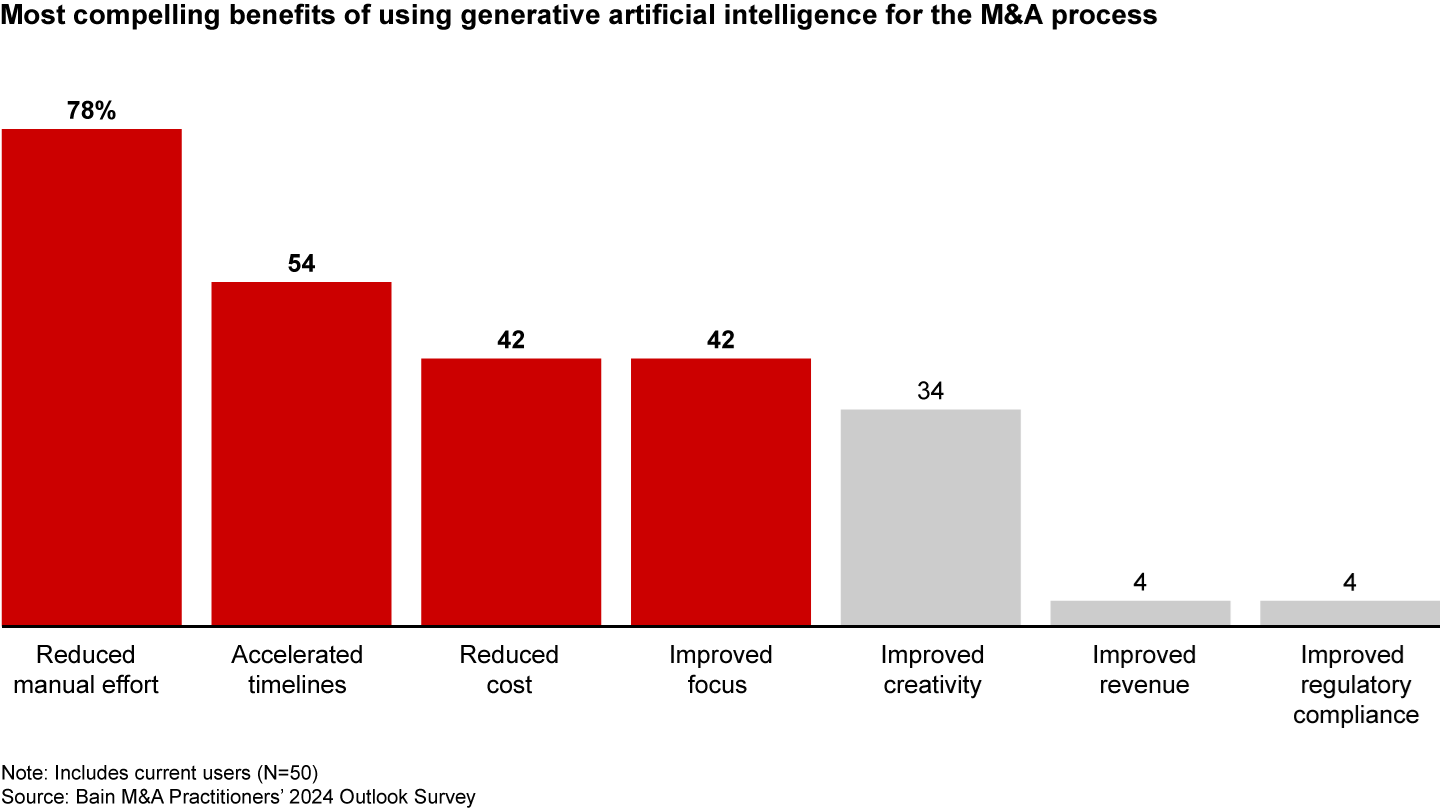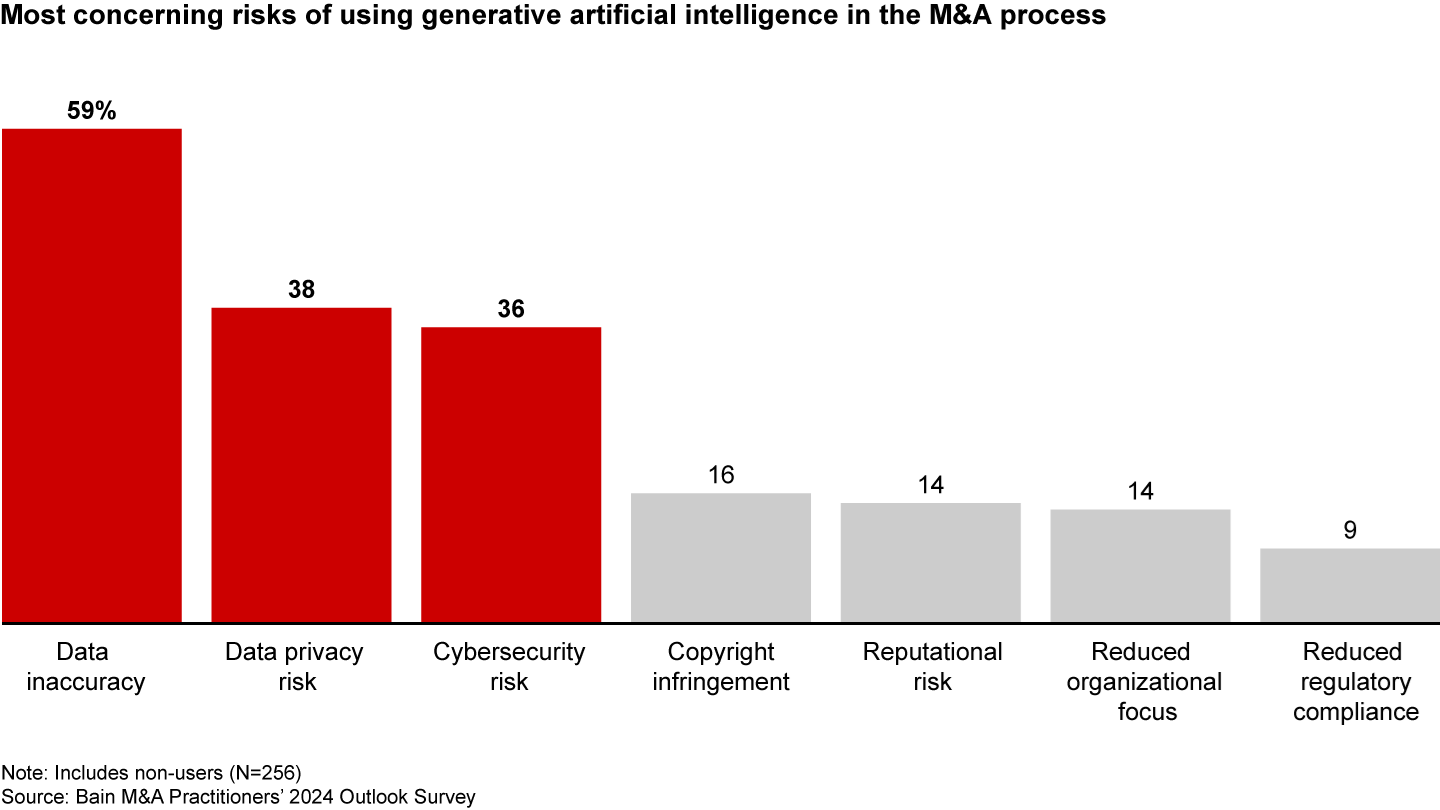M&A Report

At a Glance
- Generative AI use for M&A deal processes is low at 16% today, but it is expected to reach 80% over the next three years.
- Early adopters are using generative AI primarily to identify targets or conduct document review, and they are seeing benefits.
- 85% of current users indicated that generative AI met or exceeded their expectations.
- The biggest challenge for practitioners will be determining how to use generative AI to create a differentiated advantage.
This article is part of Bain's 2024 M&A Report.
The headlines seem relentless at times, yet the promise of generative artificial intelligence (AI) to transform so many dimensions of business is undeniable. But how are companies relying on it to improve their M&A capabilities? And what have they learned so far?
To answer those questions, we polled more than 300 M&A practitioners about their views on using generative AI in their M&A processes. New technology rarely lives up to the early hype, both in pace of change and magnitude of impact, but falling short of the hype today doesn’t mean that generative AI tools won’t offer benefits over time. Those benefits will be small to start, they will require investment to fit into a company’s current processes, and they will improve if you inject proprietary data or insights.
Only 16% of respondents are deploying generative AI today, and 16% of nonusers are likely to adopt it over the next 12 months. But 80% of respondents expect to use it within the next three years. The early adopters are primarily in technology, healthcare, and finance, and they tend to be larger companies with moderate M&A activity of three to five deals per year.
Presently, the technology is primarily used for idea generation in sourcing and reviewing data in diligence (see Figure 1). “Generative AI in the screening process can pick up targets that would not be identified with traditional tools,” said one M&A practitioner we interviewed. Another explained benefits in diligence: “Generative AI is helpful in parsing the mountain of data that needs to be reviewed. If you miss a critical fact, it can be a loss. Generative AI can be trained to parse material contracts and identify deviations from a model contract, saving time and helping to focus on problematic areas.”
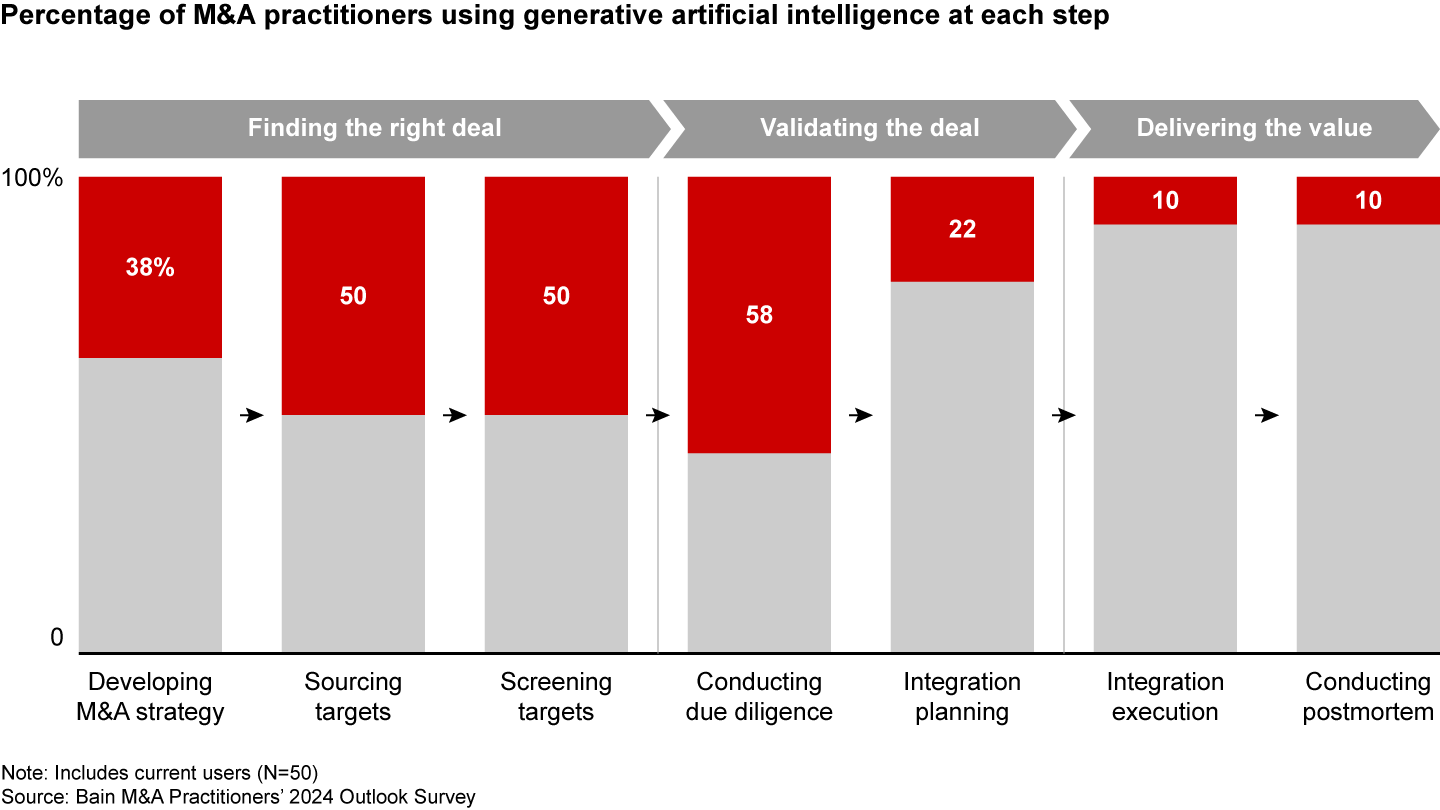
Another user discussed his company’s use of third-party tools to manage a data room, including automated filing, advanced document search, and document question and response. Among those surveyed, 78% say that they achieved productivity gains from reduced manual effort while 54% saw accelerated timelines and 42% saw reduced cost and improved focus (see Figure 2). Fully 85% of those early users report that it met or exceeded their expectations.
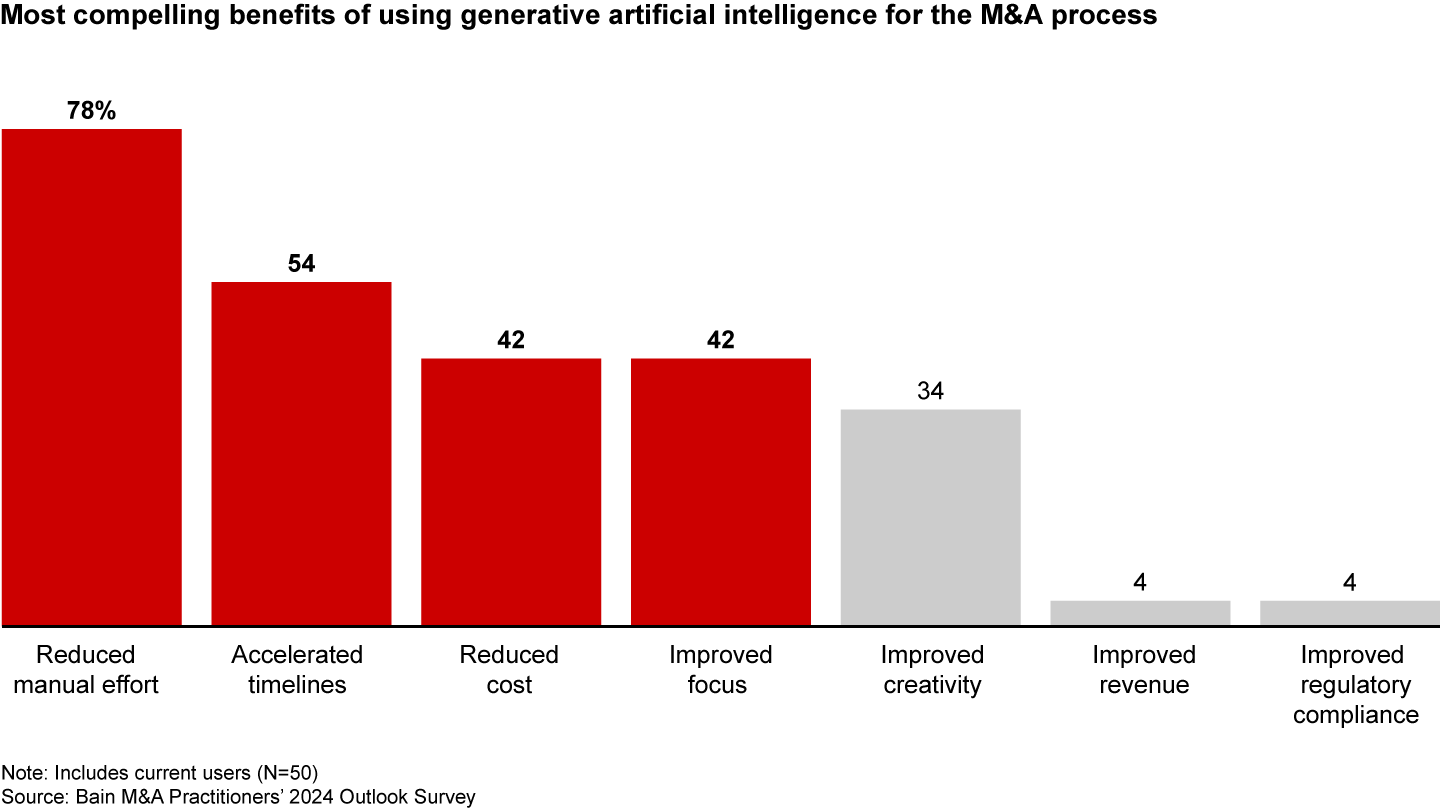
M&A practitioners were quick to point out the challenges: “In terms of realizing benefits, it takes us as much time to go through generative AI as it saves us in writing summaries or crafting reports,” said one user. “We see this period as an opportunity to get up to speed on the technology.” Others mentioned data inaccuracy: “While we expect this to get better, we now need to review or even redo the work completed by generative AI,” explained one user. Another addressed the challenges of using public information: “It’s not an issue in idea generation during screening, but it is a challenge in steps like valuing deals.” That user believes it is unlikely that targets will allow potential acquirers access to internal data to input through generative AI tools. These shortcomings were among the issues cited by nonusers. Among those surveyed, the biggest potential risks cited were data inaccuracy, privacy, and cybersecurity (see Figure 3).
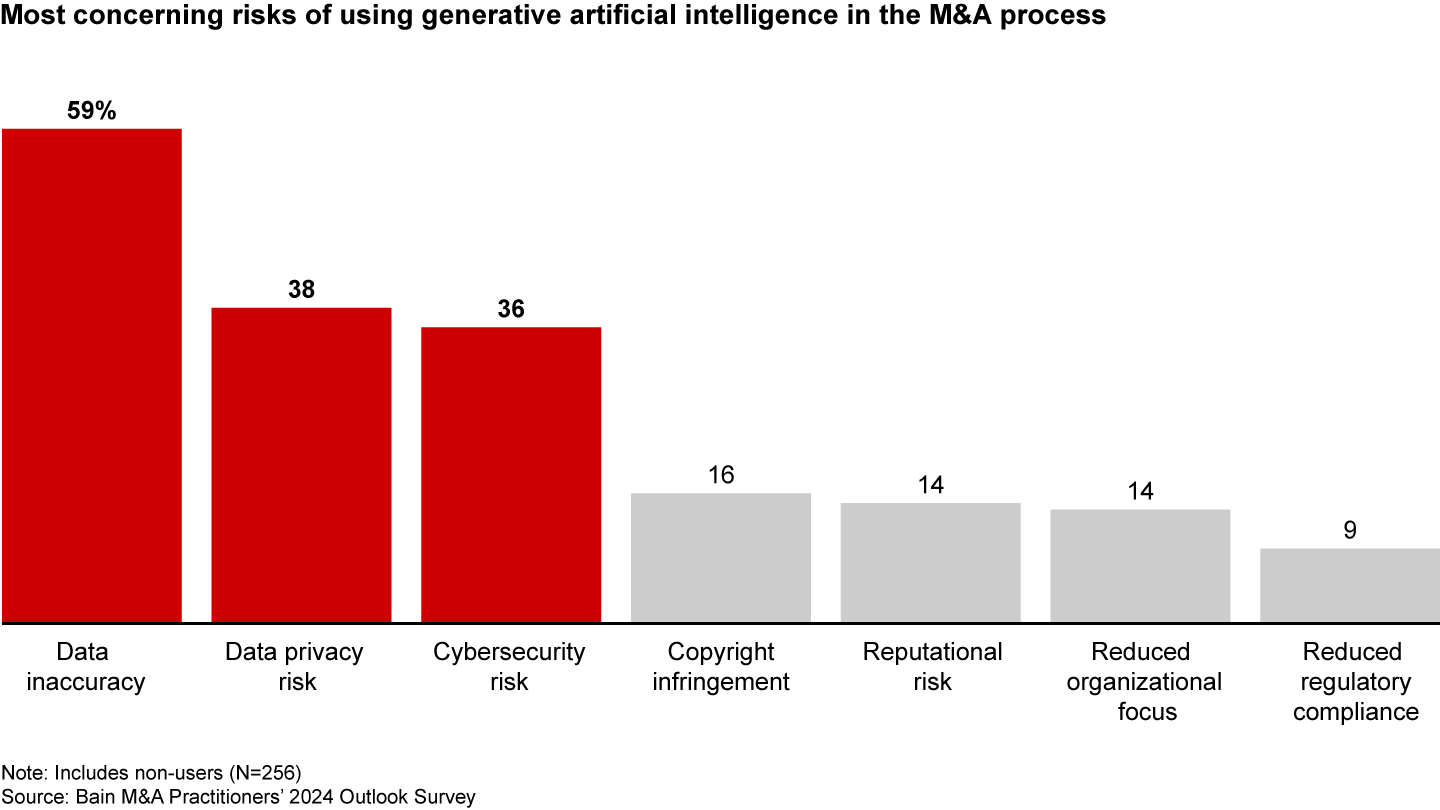
And there is another big word of caution. Being more efficient means that you can look at more deals, but it doesn’t necessarily mean you’ll make better deals. Yes, in some situations, research that took weeks to compile now can be performed in an hour, but it’s the value-added activities that you do with the extra time that make a difference. And M&A practitioners will realize that they can’t use generative AI for everything; they need to know how they can differentiate. That starts by understanding their own M&A process strengths and where they can extend them with this rapidly evolving technology.
Indeed, companies that get the most out of generative AI will invest early to identify the efficiency gains that could deliver a competitive advantage today. Using it for targeted purposes now is a way of building familiarity and setting the stage for higher-impact uses in the future. For example, technology from third-party vendors, without proprietary data or models, is sufficient today, but ultimately, most companies will need to build a more sustainable competitive edge.
Dealmakers that haven’t embarked on the generative AI journey to improve their M&A processes can start by answering three fundamental questions.
Where will generative AI’s benefits provide the most value for our organization? This is one situation for which start small is not always the right answer. Rather than starting small and scattered, look for targeted uses rich in manual effort, repetitive tasks, or creative idea generation. Test and learn your way into generative AI capabilities by applying it where you can reap real benefits. For example, an acquirer could create a tool for a newly merged salesforce to be able to respond to requests for proposals and customize offerings and pitches for the combined company.
Where can we build differentiation over time? Think now about how you could build a sustainable competitive edge. Start by preparing your data. Any frequent acquirer likely has a significant amount of relevant data available today, though it may be in difficult-to-use formats or dispersed across multiple sources. Develop a plan for how to use your data, and begin gathering it now. Your company’s insights can be amplified as they’re built into proprietary tools.
How will we mitigate risks? Today’s generative AI adopters pay close attention to the known issues associated with new technologies. They acknowledge that changes will undoubtedly take longer than expected and require thoughtful management, careful direction, and clear guardrails. For example, data accuracy matters when you are making a big M&A investment. With data inaccuracy at the top of the risk list, prioritize tasks for your generative AI tools to complete that are relatively easy to audit, and do not bypass the important step of review by a human expert. As the technology evolves, you can expect your process to do the same.
Ultimately, don’t lose sight of the biggest fact of M&A life: The best acquirers have over time and through a steady flow of deals perfected the fundamentals of dealmaking. With best-in-class M&A strategies, screening, diligence, and execution, they will consistently outperform less experienced and less rigorous peers. Generative AI can’t replace a skilled M&A practitioner in the driver’s seat.

